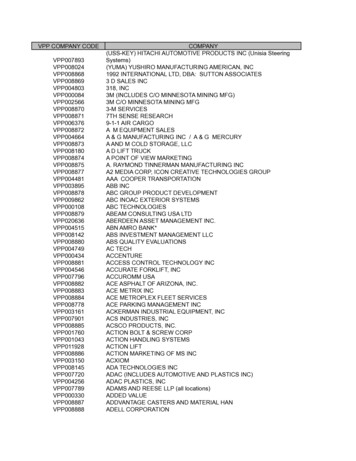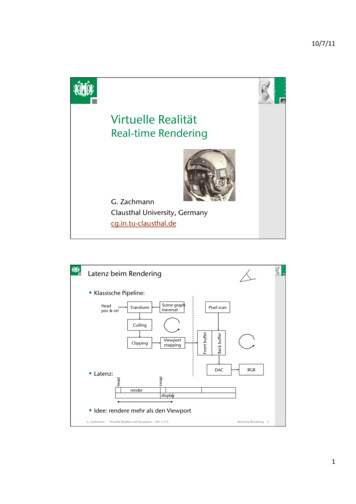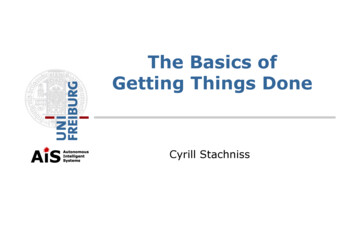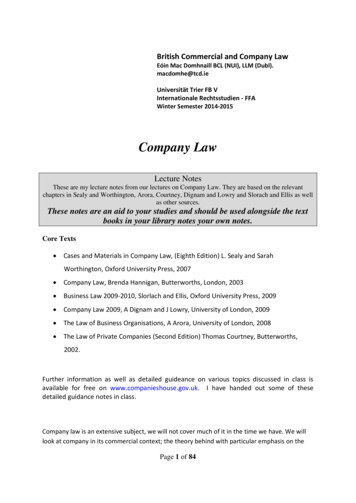
Transcription
British Commercial and Company LawEóin Mac Domhnaill BCL (NUI), LLM (Dubl).macdomhe@tcd.ieUniversität Trier FB VInternationale Rechtsstudien - FFAWinter Semester 2014-2015Company LawLecture NotesThese are my lecture notes from our lectures on Company Law. They are based on the relevantchapters in Sealy and Worthington, Arora, Courtney, Dignam and Lowry and Slorach and Ellis as wellas other sources.These notes are an aid to your studies and should be used alongside the textbooks in your library notes your own notes.Core Texts Cases and Materials in Company Law, (Eighth Edition) L. Sealy and SarahWorthington, Oxford University Press, 2007 Company Law, Brenda Hannigan, Butterworths, London, 2003 Business Law 2009-2010, Slorlach and Ellis, Oxford University Press, 2009 Company Law 2009, A Dignam and J Lowry, University of London, 2009 The Law of Business Organisations, A Arora, University of London, 2008 The Law of Private Companies (Second Edition) Thomas Courtney, Butterworths,2002.Further information as well as detailed guideance on various topics discussed in class isavailable for free on www.companieshouse.gov.uk. I have handed out some of thesedetailed guidance notes in class.Company law is an extensive subject, we will not cover much of it in the time we have. We willlook at company in its commercial context; the theory behind with particular emphasis on thePage 1 of 84
Company Lawseparate legal personality of companies and exceptions to that principle in both statute and thecommon law; the process of formation of a company; we will consider corporate governanceand the duties of a Director to a company and the protections the law offers to minorityshareholders and finally look at end of the life of a company (winding up etc.) as well asconsidering the end of partnerships.Company LawINTRODUCTIONA Company is very easily legally defined. According to Sealy and Worthington "[i]t is the kind oflegal entity or corporate body which is brought into being by the registration procedures laiddown by the Companies Act 2006 and its predecessors. Its creation is evidenced by the issue of acertificate of incorporation by the registrar of companies."This is a good definition but there are exceptions, a tiny number of companies are formedoutside of the Companies Acts. A company may also be created in the UK by Royal Charter or bya special act of Parliament. Very few of these companies still exist and they often fall outside ofgeneral company law.Everyday usage of the word company may also cause confusion. In the UK and Ireland the word"company" has other meanings in everyday speech. In particular, the abbreviation "Co." and"&Co." are commonly used as part of the name of an unincorporated partnership that is not a"company" in the strict legal sense and is occasionally used by sole traders.In the UK, except in the rare case of a company with unlimited liability, the last word of thename of a company will be "Limited" often abbreviated to "Ltd." or in the case of a publiccompany the abbreviation PLC.Company Law has a very wide scope. Company law is about the formation of companies, theircontinuing regulation during their life and the procedures for dealing with their assets whenthey are terminated on liquidation. The state consequently plays a major role in company law.However, self-regulation, as we have seen in all our Commercial law topics, also plays aPage 2 of 84
Company Lawsignificant part in the regulation of larger companies and is widely discussed in the theoreticalliterature. Like much of our course of British Commercial and Company law it is not easilycompartmentalised, tort, contract, and equity all combine.Companies have a crucial role to play in British Commercial law. Companies are the mostimportant Business structure. Their popularity is relatively recent; they came to prominence inthe Victorian era.The registered company has been the main vehicle for business activity since 1844, when theJoint Stock Companies Act 1844 was passed and provided for incorporation of companies byregistration. The current companies' legislation is the Companies Act 2006, with specificlegislation dealing with the insolvency of companies and financial services.Like other organisations, registered companies have a constitution – documents or statementsthat govern their relations internally and with third parties, internal structure and operatingprocedures. The Companies Act not only provides the facilities and procedure for registrationbut also authorises subsidiary legislation (e.g. the Companies (Model Articles) Regulations 2007,which prescribe a default constitution for registered companies).Two important topics that we have come across before and that are essential to understandinghow companies operate are separate legal personality and limited liability.Sources of Company LawxUK Companies ActsxCase lawxCommercial LifexEU Law.Types of CompanyThe Companies Acts recognises a number of types and classifications of companies.Page 3 of 84
Company LawLimited and Unlimited Companies.Section 3 defines a limited and an unlimited company.Limited and unlimited companies(1)A company is a “limited company” if the liability of its members is limited by its constitution.It may be limited by shares or limited by guarantee.(2)If their liability is limited to the amount, if any, unpaid on the shares held by them, thecompany is “limited by shares”.(3)If their liability is limited to such amount as the members undertake to contribute to theassets of the company in the event of its being wound up, the company is “limited byguarantee”.(4)If there is no limit on the liability of its members, the company is an “unlimited company”.Companies with unlimited liability are very rare. The concept of limited liability applies to theliability of the shareholders. Therefore, the liability to contribute in liquidation in respect of thecompany’s debts in the case of a limited liability company is limited to the nominal value of theshares held by each individual shareholder. A shareholder who, for example, holds 100 1shares must under the terms of issue pay the 100 to the company for his allotment, but that isthe full extent of his liability for the debts of the company, even if the company becomesinsolvent. The creditors of the company are unable to look to the shareholders for repayment ofthe company debts. The company is therefore limited by shares, although a creditor of thecompany, for example a bank, may insist on company directors giving a personal guarantee forthe company’s debt. In that case directors will not only be liable for any unpaid balance on theirshares but also separately for the value of the guarantee.It may be, however, that the company promoters (those who register the company and bring itinto existence) wish to show confidence and security to those with whom the company will dealand so they may wish to establish an unlimited company (i.e. one whose shareholders are liableto contribute for the full extent of their estate in the liquidation of the company, and thereforefor the full debts of the company).Page 4 of 84
Company LawFinally, within the distinction of limited or unlimited companies may be limited by guarantee.The purpose of such companies usually is not to trade for profit, but rather the undertaking ofbusiness for scientific, cultural or other similar purpose. A profit in such circumstances, whiledesirable where it occurs, is not distributed among the members but put back into the companyor used to further the company’s public purposes. With the company limited by guarantee,there are members but not shareholders of the company and the company’s constitution willset out the procedure by which people become members. As there are no shares by referenceto which the liability of the members for the company’s debts is limited, the limitation is insteadachieved by guarantee. This guarantee is invoked to the extent necessary if the company iswound up and is unable to pay its debts in full, but regardless of the shortfall, the liability of themembers is limited to the amount of the guarantee. Since 1980 a company can no longer beformed (or re-register) as a company limited by guarantee and with a share capital. Section 5 ofthe 2006 Act continues the prohibition (first contained in the Companies Act 1980) that acompany cannot be formed as or become a company limited by guarantee with a share capital.The fact that a company has limited liability - and so outsiders trade with or allow credit to thecompany at their own risk - must be communicated to the public under mandatory publicityrequirements required by successive Companies Acts.Private and Public CompaniesSection 4 of the Act of 2006 deals with an important division between companies, Private andPublic Companies.4 Private and public companies(1)A “private company” is any company that is not a public company.(2)A “public company” is a company limited by shares or limited by guarantee and having ashare capital—(a)whose certificate of incorporation states that it is a public company, and(b)in relation to which the requirements of this Act, or the former Companies Acts, as toregistration or re-registration as a public company have been complied with on or after therelevant date.(3)For the purposes of subsection (2)(b) the relevant date is—Page 5 of 84
Company Law(a)in relation to registration or re-registration in Great Britain, 22nd December 1980;(b)in relation to registration or re-registration in Northern Ireland, 1st July 1983.We see that companies under the Companies Act can be divided into two main categories:xpublic limited companiesxprivate limited companiesSection 4(2) of the Act defines a public company as a company limited by shares, or limited byguarantee and having a share capital.Public limited companyxA public company must satisfy a number of formalities (s.4 Companies Act 2006):The company’s certificate of incorporation must state that it is a public company.It must include the words ‘public limited company’ (or the abbreviation ‘plc’) at the end of itsname.It must satisfy the minimum capital requirements, that is, have an issued nominal capital of 50,000, of which at least 25 per cent has been paid up.The certificate of incorporation must state that the company is limited by shares.Any company that does not meet these requirements will be a private company under s.4Companies Act 2006, including:xa private company limited by sharesxa private company limited by guaranteexan unlimited company.In general, the key features of the public company are largely similar to those of a privatecompany but there are some distinguishing features:xThe shares in a public company are available to the public whereas there are often manyrestrictions on the transfer of shares in a private company.Page 6 of 84
Company LawThe divide between ownership (through shareholders) and management (through directors)tends to be more marked in a public company, with shareholders often being major financialinstitutions that invest in the company and leave its running to the directors.For the sake of completeness, Companies Legislation provides for certain other forms ofcompany.Section 6 allows for Community Interest Companies. This is a new form of Business organisationintroduced in the Act of 2006 which is designed for use by social enterprises. CommunityInterest Companies are registered under the same legislation as other registered companies, buthave to complete certain additional formalities and are subject to certain additional elements ofregulation.6 Community interest companies(1)In accordance with Part 2 of the Companies (Audit, Investigations and Community Enterprise)Act 2004 (c. 27)—(a)a company limited by shares or a company limited by guarantee and not having a sharecapital may be formed as or become a community interest company, and(b)a company limited by guarantee and having a share capital may become a communityinterest company.(2)The other provisions of the Companies Acts have effect subject to that Part.We will return to this topic after we revise our understanding of the concept of Separate LegalPersonality and how it applies to Company Law.Separate Legal Personality.The fact that a company has a separate legal personality and is a legal person in its own right isfundamental to the whole structure of Company law. Separate legal personality ensures that it,the company, owns property, it contracts with third parties, it is owned by its members anddirected by its directors, and much more.Page 7 of 84
Company LawWe will;xExamine the separate entity rule and the application of the rulexdiscuss the common law and statutory exceptions to the rule, including the issue of howparent/subsidiary companies are treated in lawxdiscuss whether or not the courts have been consistent in lifting the veil ofincorporation.Companies registered under the Companies Act have legal personality; they are treated as ‘legalpersons’ with full contractual capacity and accountable for their conduct and obligations. A keyfeature of the registered company is that it is a legal person with a separate existence from itsmembers (shareholders) and its directors. As such, the principle of separate legal personalityforms the cornerstone of company law. However, the law is prepared to look behind ordisregard the corporate principle and have regard to the human and commercial reality of thesituation. The ‘veil of incorporation’ may be lifted by the judiciary or by statute. However, it isdifficult to be precise about the circumstances in which a judge will lift it; indeed, it may be saidthat the power to do so is a tactic used by the judiciary in a flexible way to counter fraud, sharppractice, oppression and/or illegality.Salomon and SalomonThe Joint Stock Companies Act 1844 (sometimes called the Deed of Settlement Act 1844) whichlaid the basic foundation for modern company law by a system of (rather complicated)regi
Company law is about the formation of companies, their continuing regulation during their life and the procedures for dealing with their assets when they are terminated on liquidation. The state consequently plays a major role in company law. However, self-regulation, as we have seen in all our Commercial law topics, also plays a


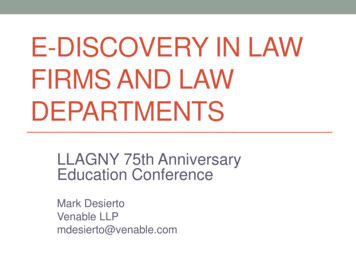
![Shareholders’ Agreement of [Company name] company. 1 .](/img/1/startup-founders-sha-sample.jpg)
